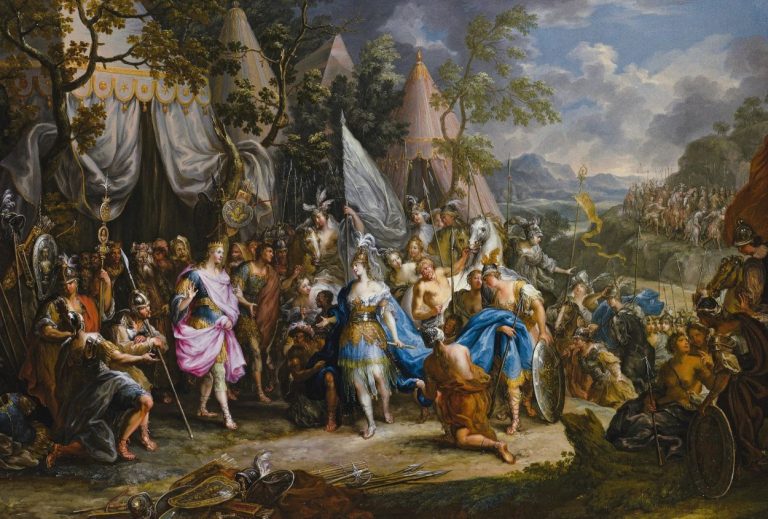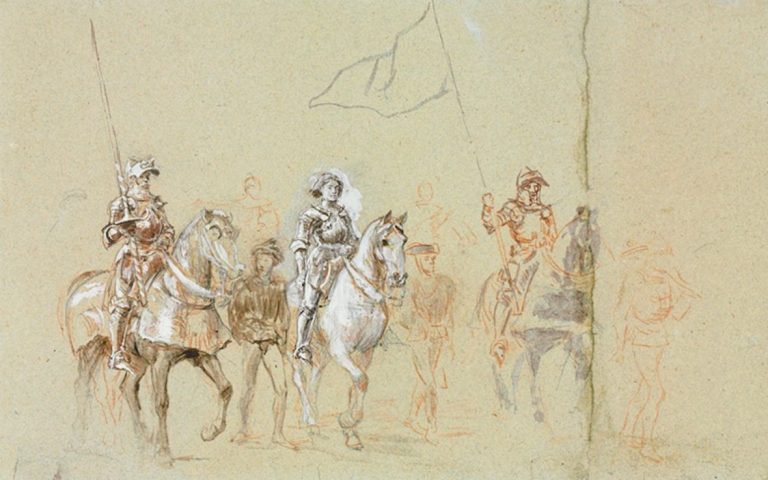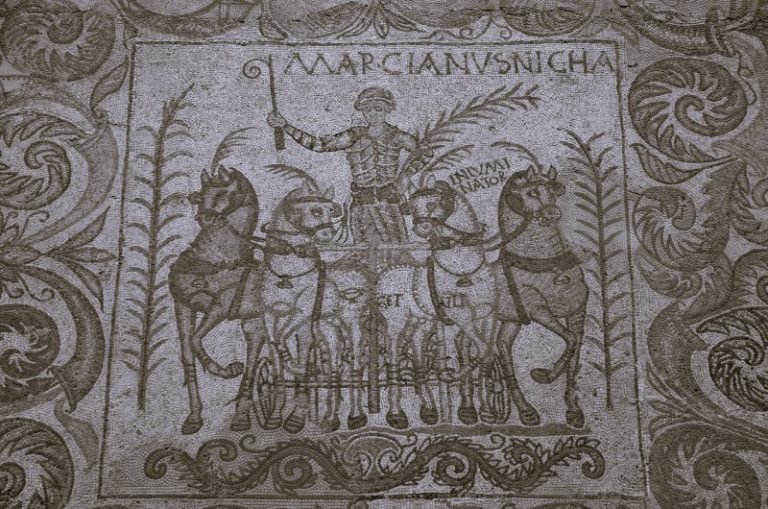
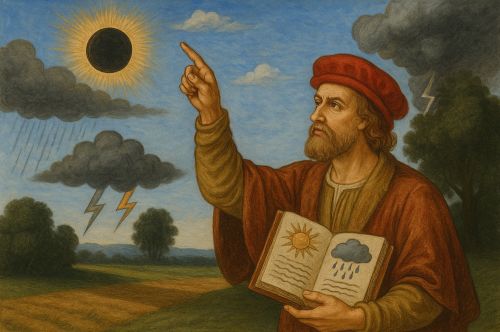
By the close of the seventeenth century, the combined use of the devices produced in this period allowed observers to track humidity, temperature, and pressure as interrelated phenomena.

By Matthew A. McIntosh
Public Historian
Brewminate
Introduction: Reading the Heavens and the Air
Between the fifteenth and seventeenth centuries, the European imagination was reshaped by the conviction that nature could be read as a text. The study of weather, long intertwined with astrological prediction and agricultural lore, began to draw upon newly fashioned instruments that could quantify the invisible. This shift did not occur abruptly, nor did it sweep away older traditions in a single intellectual tide. Rather, it emerged through the work of a small but significant group of thinkers who blended humanistic curiosity with experimental rigor.
Among them were Nicholas Cusa, who explored humidity through the hygrometer; Galileo Galilei, whose refinements to the thermometer extended human touch into measurable heat; and Evangelista Torricelli, who pierced the mystery of atmospheric pressure with his barometer.
Each of these instruments became, in their own ways, material witnesses to a growing conviction that the weather could be anticipated through knowledge rather than feared as a capricious divine sign.
Nicholas Cusa and the Measured Breath of the Air

Nicholas of Cusa (1401–1464), a cardinal and polymath, is rarely remembered in popular histories of science for his contribution to meteorology, yet his writings and experimental curiosities reveal an early concern with quantifying air’s properties.
In an age when the humidity of the air was experienced primarily through bodily sensation, the hygrometer emerged as a bridge between subjective feeling and objective record. Cusa’s design relied on organic material, wool or similar fibers, that expanded or contracted with moisture. By marking these shifts on a calibrated scale, he created a device that translated invisible atmospheric change into visible movement.1
The significance of such a device lies not merely in its mechanical ingenuity, but in its epistemological stance. To measure humidity was to admit that weather was governed by processes susceptible to human comprehension. In Cusa’s intellectual framework, natural philosophy and theology were not adversaries. The hygrometer could serve as a tool for better predicting harvest conditions, but it could also be read as part of the divine harmony of the cosmos. His thought reminds us that early meteorology did not sever itself entirely from medieval cosmology; it layered new methods over inherited beliefs.2
Galileo Galilei and the Thermometer’s Pursuit of Heat
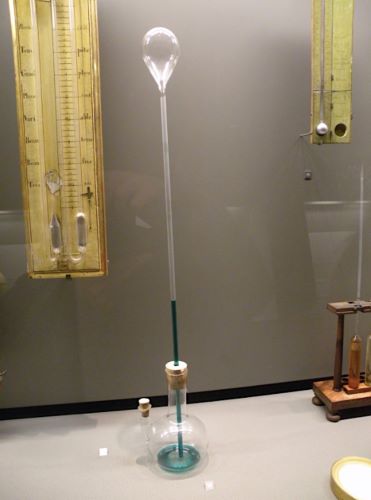
If Cusa’s hygrometer sought to grasp the wetness of the air, Galileo’s thermometer reached for its warmth. Galileo Galilei (1564–1642) did not invent the thermometer in the form we know today, yet his refinement of thermoscopic devices into a more standardized instrument marked a turning point. His thermoscope, a glass tube with a bulb at one end, relied on the expansion and contraction of air to move water in the tube. While it lacked a fixed scale, it offered a reliable way to track temperature changes over time.3
Galileo’s thermometer emerged from a context in which heat had been understood primarily through Aristotelian qualities, hot and cold as fundamental elemental properties. By rendering temperature into measurable variation, Galileo nudged natural philosophy toward quantification and repeatability. His experiments suggested that temperature was not an abstract quality but a physical phenomenon subject to universal principles. The implications for weather forecasting were immediate: temperature could now be monitored in a consistent manner, allowing patterns to be observed across days or seasons.4
One must also consider Galileo’s broader methodological influence. The thermometer was part of his larger program to replace qualitative judgments with mathematical and mechanical descriptions. In this sense, the history of weather instruments is inseparable from the history of the Scientific Revolution itself, where tools served not only to gather data but to redefine what counted as knowledge.
Evangelista Torricelli and the Weight of the Sky
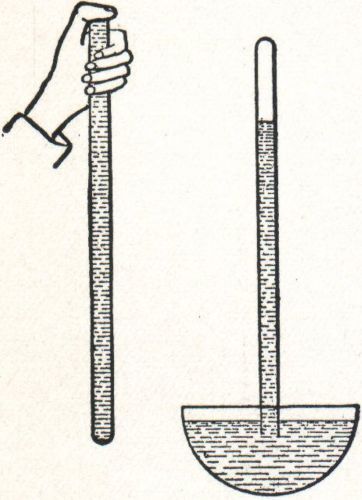
The final figure in this triad, Evangelista Torricelli (1608–1647), brought the investigation of weather into direct engagement with atmospheric pressure. His invention of the mercury barometer in 1643 was a landmark in both physics and meteorology. By filling a glass tube with mercury and inverting it into a basin, Torricelli observed that the mercury column fell to a certain height and varied with changing weather. He concluded that the air itself had weight and that fluctuations in this weight corresponded with shifts in weather conditions.5
The barometer’s importance for forecasting lay in its capacity to detect changes invisible to the eye. Falling mercury levels often preceded storms, while rising levels suggested fairer conditions. This was more than a technical achievement; it was a conceptual leap. For centuries, the notion that air could exert force had been counterintuitive to many natural philosophers. Torricelli’s work demonstrated that the sky was not empty but a material medium pressing constantly upon the earth. In a single apparatus, he joined empirical observation with a theoretical framework that could predict the future state of the atmosphere.6
Torricelli’s insight also exemplifies the emerging separation of meteorology from astrology. By tying weather changes to measurable pressure differences, he anchored prediction in a physical cause rather than celestial influence. The barometer thus became both a scientific instrument and a symbol of a new intellectual confidence in reading the “book of nature” without recourse to the stars.
Conclusion: Instruments as Agents of Intellectual Transformation
The hygrometer, thermometer, and barometer were not simply technical tools; they were cultural artifacts in the making. In their hands, Cusa, Galileo, and Torricelli transformed the study of weather from an interpretive art into an observational science. Yet these transformations were gradual and layered. Early modern weather forecasting remained, for a time, a hybrid field, still accommodating older explanatory models while absorbing the precision of new instruments.
By the close of the seventeenth century, the combined use of these devices allowed observers to track humidity, temperature, and pressure as interrelated phenomena. This marked the first time in European history that the atmosphere could be understood as a dynamic system subject to measurement. In this sense, the Renaissance weather instrument was not just a passive recorder of environmental change. It was a declaration of faith in human capacity to anticipate, and perhaps even to master, the caprices of the sky.
Appendix
Footnotes
- Nicholas of Cusa, Idiota de Staticis Experimentis, in Opera Omnia, vol. 2, ed. Ernst Hoffmann (Hamburg: Meiner, 1932), 145–148.
- Jasper Hopkins, Nicholas of Cusa on Learned Ignorance: A Translation and an Appraisal (Minneapolis: Arthur J. Banning Press, 1985), 73–76.
- Stillman Drake, Galileo at Work: His Scientific Biography (Chicago: University of Chicago Press, 1981), 249–253.
- William R. Shea, Galileo’s Intellectual Revolution, (New York: Macmillan, 1972), 4–6.
- Evangelista Torricelli, Opera Geometrica (Florence: Amador Massi and Lorenzo Landi, 1644), 191–198.
- W.E. Knowles Middleton, The History of the Barometer (Baltimore: Johns Hopkins Press, 1964), 23–28.
Bibliography
- Drake, Stillman. Galileo at Work: His Scientific Biography. Chicago: University of Chicago Press, 1981.
- Hopkins, Jasper. Nicholas of Cusa on Learned Ignorance: A Translation and an Appraisal. Minneapolis: Arthur J. Banning Press, 1985.
- Middleton, W.E. Knowles. The History of the Barometer. Baltimore: Johns Hopkins Press, 1964.
- Nicholas of Cusa. De Staticis Experimentis. In Opera Omnia, vol. 2, edited by Ernst Hoffmann, 145–148. Hamburg: Meiner, 1932.
- Shea, William R. Galileo’s Intellectual Revolution. New York: Macmillsn, 1972..
- Torricelli, Evangelista. Opera Geometrica. Florence: Amador Massi and Lorenzo Landi, 1644.
Originally published by Brewminate, 08.13.2025, under the terms of a Creative Commons Attribution-NonCommercial-NoDerivatives 4.0 International license.
